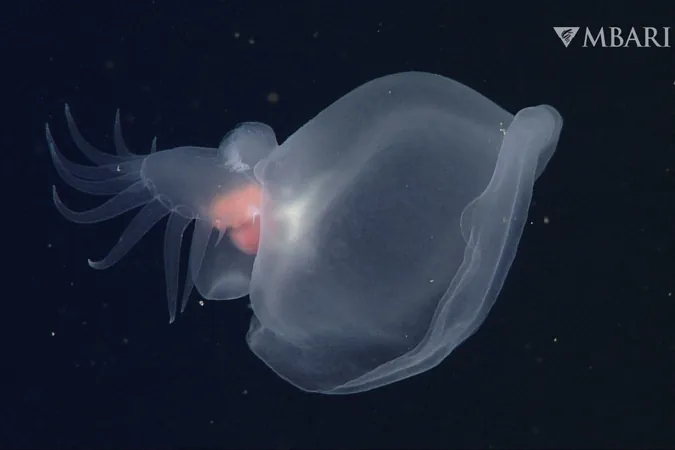
Discovering the Astonishing Glowing Sea Creature of the Ocean's Deepest Depths!
2024-11-12
Author: Lok
Introduction
In an incredible revelation from the depths of the ocean, scientists have unveiled detailed insights about a mesmerizing sea creature previously referred to as the "mystery mollusk." This extraordinary animal, scientifically named Bathydevius caudactylus, has captured the attention of researchers and ocean enthusiasts alike due to its peculiar form and bioluminescent abilities.
Discovery and Classification
B. caudactylus was first spotted in 2000 by a remotely operated vehicle (ROV) in the stunning Monterey Bay off the coast of California. Remarkably, it took nearly 25 years to classify this unique species accurately within the animal kingdom. Senior scientist Bruce Robison from the Monterey Bay Aquarium Research Institute termed the recent study as “the most comprehensive description of a deep-sea animal ever made.”
The findings were published in the journal Deep-Sea Research Part I, following over 150 additional sightings attributed to MBARI's ROV explorations. Moreover, researchers successfully retrieved a specimen, allowing them to conduct thorough anatomical and genetic analyses. The conclusion? This captivating creature is a nudibranch, commonly recognized as a sea slug—yet it is unlike any other known to exist in the abyssal zones of our planet.
Unique Features and Bioluminescence
What sets B. caudactylus apart is its habitat; it thrives between 3,300 feet and 13,100 feet deep—the ocean's so-called ‘midnight zone.’ But what truly fascinates scientists is its otherworldly morphology. The creature possesses a gelatinous hood and a paddle-like tail with finger-like appendages. Perhaps most spellbinding is its ability to glow in the dark—a phenomenon making it one of the rare bioluminescent nudibranchs.
This discovery evokes comparisons to the infamous platypus, which left early scientists baffled due to its combination of features from various animals. The first time researchers observed B. caudactylus emitting light while filmed with the ROV, it elicited audible awe from those in the control room, highlighting its astonishing beauty.
Defense Mechanisms and Adaptations
The researchers uncovered that the sources of bioluminescence are tiny glowing granules scattered throughout the creature’s hood and tail. In a fascinating defensive mechanism, these animals can lose one of their glowing limbs, effectively distracting predators while they escape. Fortunately, these dactyls are capable of regeneration, enabling the creature to recover quickly.
Conclusion and Future Exploration
With recent advancements in camera technology allowing for high-resolution and full-color imaging of bioluminescence, MBARI stands out as one of the few entities capable of undertaking deep-ocean explorations to observe these luminous phenomena in their natural environments.
Measuring around 5.6 inches (14.5 centimeters), B. caudactylus primarily feeds on crustaceans using its funnel-shaped mouth, prominently located at the rear of its flexible hood. The creature’s hermaphroditic nature allows it to reproduce on the seafloor at depths equivalent to stacking nine Empire State Buildings on top of one another.
In terms of lifestyle, B. caudactylus exhibits a lower metabolism compared to other nudibranchs, with respiration rates mirroring those of deep-sea jellyfish. This adaptation aligns with its life in the challenging deep-sea environment, where it glides effortlessly through the water, often drifting with the ocean currents.
Despite covering approximately 70% of Earth’s surface, the oceans remain one of our planet’s most mysterious frontiers. Current estimates suggest that around 67% of the millions of species believed to inhabit the ocean have yet to be identified—an adventure waiting to unfold beneath the surface.
This remarkable discovery serves as a reminder that the mysteries of our world are far from over. Every new encounter offers us fresh insights into Earth's biodiversity and reinforces the idea that, no matter how much we learn, there are always hidden wonders yet to be revealed in the ocean’s depths. Stay tuned as science continues to untangle the secrets of our planet’s most secretive realms!


 Brasil (PT)
Brasil (PT)
 Canada (EN)
Canada (EN)
 Chile (ES)
Chile (ES)
 España (ES)
España (ES)
 France (FR)
France (FR)
 Hong Kong (EN)
Hong Kong (EN)
 Italia (IT)
Italia (IT)
 日本 (JA)
日本 (JA)
 Magyarország (HU)
Magyarország (HU)
 Norge (NO)
Norge (NO)
 Polska (PL)
Polska (PL)
 Schweiz (DE)
Schweiz (DE)
 Singapore (EN)
Singapore (EN)
 Sverige (SV)
Sverige (SV)
 Suomi (FI)
Suomi (FI)
 Türkiye (TR)
Türkiye (TR)